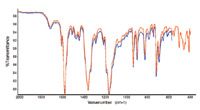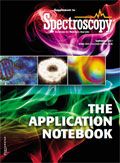Expanded Spectral Range Germanium ATR Crystal
Application Notebook
Experimental data show the crystal dimensions of an ATR-FT-IR sampling accessory influence the usable spectral range. An expanded range germanium crystal is introduced for the measurement of high refractive index samples.
Experimental data show the crystal dimensions of an ATR-FT-IR sampling accessory influence the usable spectral range. An expanded range germanium crystal is introduced for the measurement of high refractive index samples.
Attenuated total reflection (ATR) for FT-IR sampling requires that the beam angle of incidence (AOI) is greater than the critical angle, which is defined as sin-1 (n2/ n1) where n2 and n1 are the refractive index of the sample and ATR crystal, respectively (1). For high refractive index materials a germanium crystal is often necessary to reduce the critical angle to below 45°, the most common AOI for single reflection ATRs.
The spectral range of ATR crystals, which is a function of the crystal type and geometry, is one consideration when choosing an ATR accessory. This application note investigates the spectral cut-off of Ge ATR accessories, and discusses the benefits of an expanded range Ge crystal for certain samples.
Experimental Conditions
PIKE Technologies' GladiATR single reflection ATR equipped with a Ge crystal was used to collect an infrared spectrum of malachite green oxalate. The Ge crystal surface where the beam enters the crystal has been treated with an anti-reflective coating to enhance the energy throughput, generally greater than 35% at 1000 cm-1. Data collection time was 1 min, and the resolution was 4 cm-1. A spectrum of the sample was also collected with PIKE Technologies' single reflection MIRacle ATR equipped with a Ge crystal using the same instrument and collection parameters.
Results
The spectral range of a Ge ATR crystal decreases as the distance the beam travels within the crystal increases. The MIRacle single reflection ATR has a small sampling surface, 1.8 mm diameter, yet the beam travel distance inside the crystal is approximately 18 mm because the crystal is dome-shaped and serves as a refractive optic. Alternatively, the GladiATR single reflection ATR uses all reflective optics and a circular prism-shaped crystal with a sampling surface of 2 mm diameter and 45° side angles. The beam travel distance through the GladiATR crystal is 2.5 mm.

Figure 1: A comparison of the expanded spectral range of the GladiATR using a Ge ATR crystal (in red) at the low vibrational frequencies to the range of the MIRacle Ge ATR (in blue); sample is malachite green oxalate.
Malachite green oxalate, a material dye, serves as an ideal sample for ATR sampling on a Ge crystal because of its high refractive index. The sample spectrum shows the effect of crystal dimensions (Figure 1). The MIRacle offers a spectral range of 4000–575 cm-1, whereas the GladiATR's useable spectral range is 4000 – 420 cm-1, providing additional spectral information across the low vibrational frequencies. Types of high refractive materials that would benefit from sampling on an expanded range Ge ATR crystal include inorganic materials such as oxides, aluminas, titania, and minerals.
Conclusions
An ATR accessory with a compact-size Ge crystal in combination with all reflective optics offers an expanded spectral region, from 4000 to 420 cm-1, which is beneficial when testing high refractive index materials.
PIKE Technologies would like to acknowledge Fiveash Data Management, Inc. for providing malachite green oxalate from their dye spectral database sample collection.
Reference
(1) PIKE Technologies. ATR: Theory and Applications. www.piketech.com.
PIKE Technologies
6125 Cottonwood Drive, Madison, WI 53719
tel. (608) 274-2721, fax (608) 274-0103
Website: www.piketech.com

Thermo Fisher Scientists Highlight the Latest Advances in Process Monitoring with Raman Spectroscopy
April 1st 2025In this exclusive Spectroscopy interview, John Richmond and Tom Dearing of Thermo Fisher Scientific discuss the company’s Raman technology and the latest trends for process monitoring across various applications.
A Seamless Trace Elemental Analysis Prescription for Quality Pharmaceuticals
March 31st 2025Quality assurance and quality control (QA/QC) are essential in pharmaceutical manufacturing to ensure compliance with standards like United States Pharmacopoeia <232> and ICH Q3D, as well as FDA regulations. Reliable and user-friendly testing solutions help QA/QC labs deliver precise trace elemental analyses while meeting throughput demands and data security requirements.